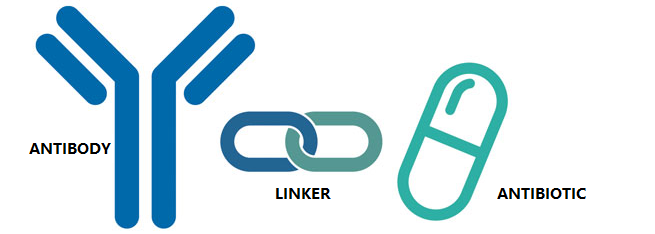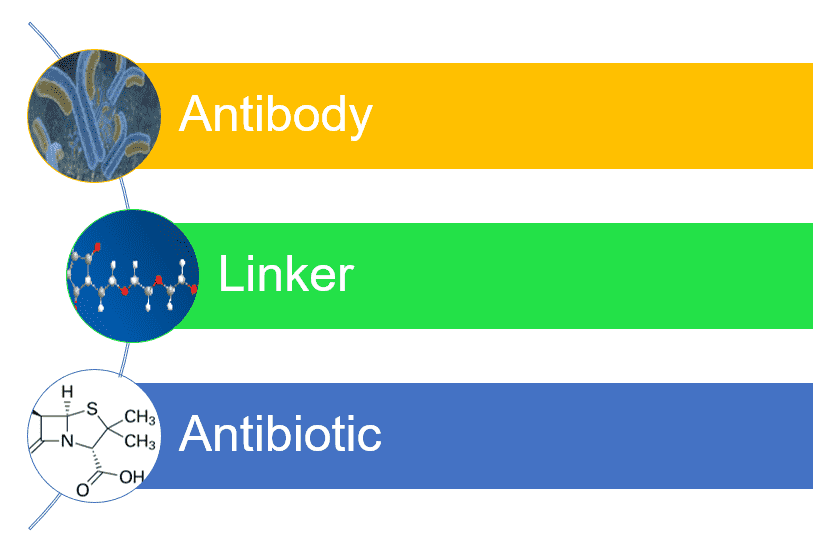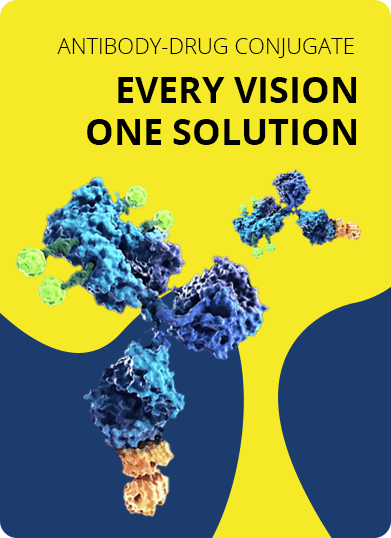- Home
- UTC Development
- Antibody-Antibiotic Conjugate (AAC) Development
Antibody-Antibiotic Conjugate (AAC) Development Services
Overview
Using antibodies to treat infections has had a long history and is one of the earliest effective therapies in fighting bacteria, even before the discovery of antibiotics. However, these early attempts usually suffer from immunological complications like hypersensitivity and serum sickness, mostly owing to the use of heterologous sera. Nowadays, antibodies can be produced using highly engineered recombinant systems, resulting in superb specificity and very low immunogenicity. For bacterial infections, antibodies provide all around protection for host cells in virtually every stage of the pathogenesis process. On the other hand, antibiotics, the most commonly used antibacterial agents in the last century, are considered as one of nature’s greatest presents to human - they have significantly reduced the mortality from various infections. Despite of the groundbreaking success of antibiotics in modern medicine, their limitations have also emerged: these small-molecule drugs are diverse in structure which makes it difficult to achieve predictable pharmacokinetic and pharmacodynamic properties; increasing number of infections have become resistant to antibiotics; discovery of novel antibiotics is a lengthy and costly process.

Challenges
The discovery of antibiotics has led to significant gains in human health and longer lives of the past century. However, bacteria and other microorganisms can quickly adapt to antimicrobial treatment by DNA transfer and spontaneous mutation - their ultimate weapon to survive for thousands of years. This self-defense mechanism of bacteria has led to the generation of multi-drug resistant strains which have invariably become a major health threat to mankind.
While multi-drug resistance is turning once curable diseases into killers again, there are very few antibiotics being approved every year, and most new products are “follow-up” compounds meaning that they have the same mechanism of action as the existing ones. This is caused, for the most part, by the high regulatory burden and research cost of developing novel antibiotics.
To address these challenges, a new class of therapeutic modality has been discovered that combines the advantages of antibodies and antibiotics to give a hybrid format - antibody-antibiotic conjugate (AAC). AAC is designed to have key properties of both antibody and antibiotic in that it displays enhanced ADME (adsorption, distribution, metabolism, excretion) that are compared to antibodies while having superior target specificity adopted from small-molecule drugs. Studies (Mariathasan, S. and Tan, M.-W.) have shown that AACs are expected to show improved efficacy and specificity against multi-drug resistant bacteria, and will open a new avenue in future antimicrobial discovery.
 Fig.1 Structural representation of AAC.
Fig.1 Structural representation of AAC.
Structural Design of AAC
Similar to antibody-drug conjugate (ADC), an AAC contains three components: an antibody selectively delivers the whole molecule to its target, an antibiotic for bacteria killing and a synthetic linker that connects the two. To work effectively against bacteria, the AAC must meet specific requirements including safety, efficacy, stability so as to precisely kill the target bacteria without causing damages to other cells and tissues. The three components in AAC are all playing pivotal roles in determining overall selectivity and specificity, degree of safety and mode of action.

Creative Biolabs is an established supplier for antibody and ADC-related services. Over the past decade, we have gained extensive experience in antibody engineering, payload screening, linker design and pharmacological evaluation. Now we have extended our expertise to the field of AAC development, aiming to provide quality products and services for the discovery of next generation antibacterial agents. With our well-established DrugLnk™ and antibody engineering platforms, we are dedicated to offering the best services to promote your AAC development. Our services include but not limited to:
- Antibody Discovery Services for Bacterial Infection
- Linker Design and Synthesis
- Antibiotic Synthesis
- Antibody-antibiotic Conjugate
- AAC in vitro Analysis
- AAC in vivo Analysis
Please contact us for more information and a detailed quote.
Reference:
- Mariathasan, S.; Tan, M. W. (2017). “Antibody-Antibiotic Conjugates: A Novel Therapeutic Platform against Bacterial Infections.” Trends in Molecular Medicine 23 (2): 135-149.
For Research Use Only. NOT FOR CLINICAL USE.

Online Inquiry
Welcome! For price inquiries, please feel free to contact us through the form on the left side. We will get back to you as soon as possible.
